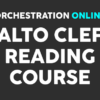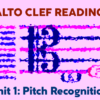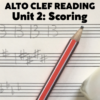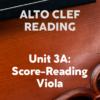This book is the “Behind Bars” of Film Scoring, with every detail of the process carefully considered and clearly laid out for both university students and working professionals. Though it’s even more pricey than Sam Adler’s “Study of Orchestration” listed above, I’ve heard some film orchestrators say that John William’s introduction to the book alone was worth the price. I wouldn’t go that far myself, but there’s no denying that this is really a thorough text on the subject, with numerous samples and assignments to help composers polish their skills and approaches.
« The Art of Music Copying by Clinton Roemer
Complete Guide to Film Scoring: The Art and Business of Writing Music for Movies and TV by Richard Davis »
Related Posts
ALTO CLEF READING COURSE ORIENTATION
Welcome to the Orchestration Online Alto Clef Reading Course, designed to quickly and permanently im
ALTO CLEF READING, UNIT 1: PITCH RECOGNITION
FINDING A USEFUL SYSTEM When I was just about 14, I switched over from the violin to viola in my jun
ALTO CLEF READING, UNIT 2: SCORING
Note: make sure to read my first tip in this course on Alto Clef concerning Pitch Recognition, downl
ALTO CLEF READING UNIT 3A: VIOLA
If you’re new to reading the alto clef, but you’ve taken the time to drill yourself on Pitch Recogni
ALTO CLEF READING UNIT 3B: ALTO TROMBONE
If this is your first look at my Alto Clef Reading Course, jump back to the my first two sections on
ALTO CLEF READING UNIT 3C: CONTRALTO VOICE
This represents the final post in my series, “Alto Clef Reading Tips and Drills.” Make sure that you
ALTO CLEF READING, UNIT 4A: 100 SIGHT-SINGING DRILLS
100 ALTO CLEF SIGHT-SINGING DRILLS By this point in my Alto Clef Reading Course, you should have sha
Orchestration Tip: Horn Middle Register
For better control in delicate scoring, use the horn’s middle register, especially in the octave bet








